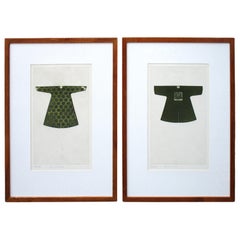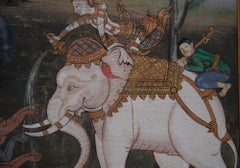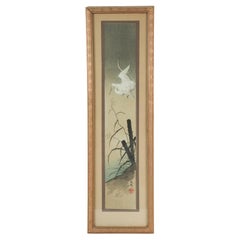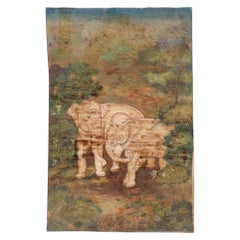Thai Prints
to
2
2
1
1
1
2
1
1
1
12,365
379
365
317
46
2
2
2
Place of Origin: Thai
Two Framed Etchings of Traditional Chinese Costumes by Vorakorn Metmanorom
Located in Rochester, NY
Two etchings of traditional Chinese costumes decorated w/ Chinese calligraphy by world renowned artist Vorakorn Metmanorom ( Thailand, b. 1968 ) At the 1995 National Exhibition of Ar...
Category
Late 20th Century Qing Thai Prints
Materials
Glass, Wood, Paper
19th C. BALINESE ELEPHANT SCENIC-SCAPE Painting
Located in Hawthorne, CA
Listing Description – 19th-Century Balinese White Elephant Allegorical Painting, Color on Cloth with Gilt
An exquisite and richly symbolic 19th-century Balinese painting, rendered i...
Category
Mid-19th Century Other Antique Thai Prints
Materials
Paint, Paper
Related Items
Antique Taisho Period Tanzaku Woodblock Print of Heron at Twilight by Seiko
By Seiko
Located in Philadelphia, PA
A fine antique Taisho period Japanese woodblock print.
Depicting a swooping heron above a riverbed with a thin sliver of a crescent moon in the background.
By Seikо̄. Seikо̄ is tho...
Category
Early 20th Century Taisho Thai Prints
Materials
Paper
$495
H 17.63 in W 5.25 in D 0.75 in
Antique Thai White Elephant Painting on Cloth, Rattanakosin School
Located in Point Richmond, CA
Antique Thai White Elephant Painting on Cloth, Rattanakosin School, 19th Century.
A painted scene of two white auspicious elephants in a landscape setting. In Thai Buddhist folklore,...
Category
19th Century Other Antique Thai Prints
Materials
Canvas
$800
H 30.75 in W 22.75 in D 0.75 in
Balinese Traditional Painting by W. Erawati
Located in Point Richmond, CA
Balinese Traditional Painting, acrylics on canvas by W. Erawati. The scene depicts a dense composition of village life just outside of a temple on a festival day with the numerous fi...
Category
Late 20th Century Other Thai Prints
Materials
Canvas
Japanese Antique Bold Hand-Painted "Two Horses" Silk Scroll, Meiji Period
Located in South Burlington, VT
A bold, spectacular Japanese hand-brushed, hand-painted silk scroll of two horses below plumb tree mountain- worthy of your favorite room
Hand painting on silk in simple soft pleasin...
Category
Late 19th Century Meiji Antique Thai Prints
Materials
Silk
$225
H 65 in W 19.5 in D 1 in
Ryohei Tanaka Etching Japan c1989
By Tanaka Ryohei
Located in Oakland, CA
Incredibly detailed Ryohei Tanaka etching of a structure on the Japan countryside c1989. Beautifully framed and matted in a custom rounded edge teak frame. Signed in pencil by artist...
Category
1980s Modern Vintage Thai Prints
Materials
Plexiglass, Teak, Paper
Japanese Framed Wood Block Print Of A King With Chop Mark
Located in Bridgeport, CT
Vintage Asian woodblock print on rice paper of a Horse mounted King with a Tree, Bird and Sun Mandalas floating above and surmounting three figures in an open pavilion. Cinnabar chop...
Category
20th Century Edo Thai Prints
Materials
Hardwood, Paper
Ryohei Tanaka Etching Japan c1995
By Tanaka Ryohei
Located in Oakland, CA
Incredibly detailed Ryohei Tanaka etching of a temple in Japan c1995. Beautifully framed and matted in a custom rounded edge teak frame.
Ryohei Tanaka (1933-2019) was world renowned...
Category
1990s Modern Thai Prints
Materials
Plexiglass, Teak, Paper
Chinese Framed Print of Tang Dynasty Painting
By Han-Kan
Located in Savannah, GA
Chinese framed print detail of larger painting. Expertly framed with double mats of linen and simulated bamboo featuring gold leaf edging on both mats.
"Han-Kan Bringing Tribute" New...
Category
15th Century and Earlier Tang Antique Thai Prints
Materials
Chrome
English Oil Painting Ship Sea Scape Maritime Art
Located in Potters Bar, GB
Wonderful English oil painting of a ship in a vivid blue ocean
Artist has really captured the beauty to the scene with great skill
Comes in the gilt frame
Piece is signed J Hardey in bottom right corner
Please let us know if you would like to view this piece in our Canonbury Antiques...
Category
1980s Vintage Thai Prints
Materials
Paint
Antique Framed Japanese Shunga Woodblock Print of Two Women Making Love
Located in Yonkers, NY
An antique Japanese Shunga woodblock print in gilt frame depicting two women making love. Created in Japan, this woodblock print called a Shung...
Category
19th Century Antique Thai Prints
Materials
Glass, Wood, Paint
$1,200
H 13 in W 15.5 in D 1 in
Ryohei Tanaka Etching Japan c1993
By Tanaka Ryohei
Located in Oakland, CA
Incredibly detailed Ryohei Tanaka etching of a structure on the Japan countryside c1993. Beautifully framed and matted. Signed in pencil by artist.
Ryohei Tanaka (1933-2019) was wor...
Category
1990s Modern Thai Prints
Materials
Glass, Wood, Paper
"19th-Century Dog Portrait: Charming Canine Art"
Located in Southall, GB
This charming 19th-century dog portrait beautifully captures the personality and spirit of its canine subject with remarkable detail. The artist’s skillful brushwork highlights the dog’s expressive eyes, textured fur, and lifelike stance, creating an intimate and endearing portrayal. Reflecting the era’s appreciation for pets and animal companions, this painting blends realism with warmth, showcasing the unique bond between humans and dogs. Ideal for collectors of antique animal art...
Category
19th Century Antique Thai Prints
Materials
Glass
Recently Viewed
View AllMore Ways To Browse
Vintage Wine Demijohn
Vintage Wooden Puzzles
Warranted China
Wax Jack
Weller Wall Pocket
White Porcelain Parrots
Wiener Werkstatte Glazed
Wig Box
Wine Caddy
Worcester Dessert Plate
Yuan Dynasty Blue And White Porcelain
17th Century Game Table
18th Century Mahogany Dresser
18th Century Meissen Plates
1920 File Cabinet
1950s Giraffe
19th Century German Silver Tea Sets
19th Century Shanxi Elm Table



